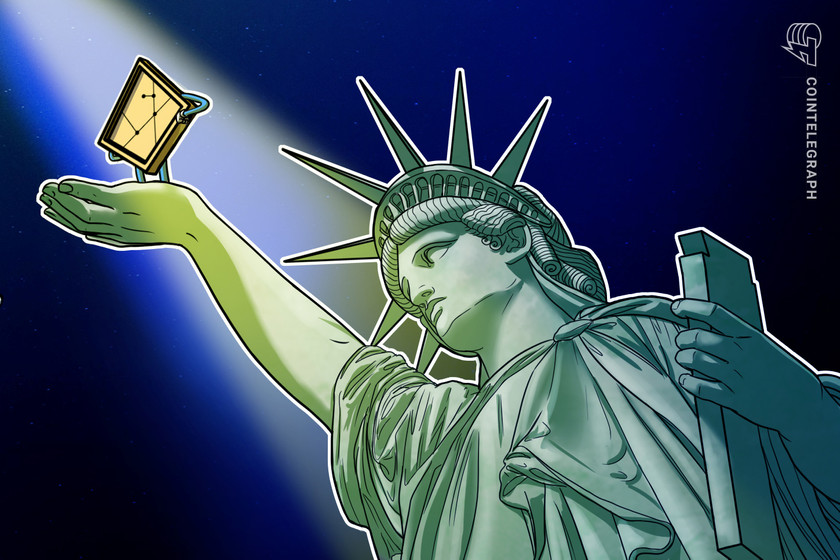 Ticketmaster, the global provider of event ticketing services, has launched “token-gated sales,” allowing fans access to concert tickets using non-fungible token (NFT) technology. The first to use the service is the metal band Avenged Sevenfold (A7X), whose “Deathbats Club” NFT collection gave owners early access to the group’s shows in Los Angeles and New York […]
Ticketmaster, the global provider of event ticketing services, has launched “token-gated sales,” allowing fans access to concert tickets using non-fungible token (NFT) technology. The first to use the service is the metal band Avenged Sevenfold (A7X), whose “Deathbats Club” NFT collection gave owners early access to the group’s shows in Los Angeles and New York […] Mayor of New York City Eric Adams took a supportive, if somewhat veiled, stance on the partial crypto mining ban imposed in the state. A law signed by fellow Democrat and New York Governor Kathy Hochul temporarily limits the minting of digital currencies using fossil fuels. New York Mayor and Bitcoin Supporter Eric Adams to […]
Mayor of New York City Eric Adams took a supportive, if somewhat veiled, stance on the partial crypto mining ban imposed in the state. A law signed by fellow Democrat and New York Governor Kathy Hochul temporarily limits the minting of digital currencies using fossil fuels. New York Mayor and Bitcoin Supporter Eric Adams to […] The troubled crypto hedge fund Three Arrows Capital Ltd., otherwise known as 3AC, has filed for bankruptcy according to recent court filings. The court papers show 3AC is aiming for an ancillary Chapter 15 proceeding so liquidators and creditors cannot seize the firm’s U.S. assets. 3AC Files for Bankruptcy — ‘Tremors’ From the Crypto Market […]
The troubled crypto hedge fund Three Arrows Capital Ltd., otherwise known as 3AC, has filed for bankruptcy according to recent court filings. The court papers show 3AC is aiming for an ancillary Chapter 15 proceeding so liquidators and creditors cannot seize the firm’s U.S. assets. 3AC Files for Bankruptcy — ‘Tremors’ From the Crypto Market […]
A key derivatives metric used by margin traders has hit a record-high, but there’s plenty of risk and a catch to consider.
Bitcoin (BTC) has been unable to close above $32,000 for the past 28 days, frustrating bulls and pushing the Fear and Greed index to bearish levels below 10. Even with June 6’s small boost, the tech-heavy Nasdaq stock market index is down 24% year-to-date.
Investors who keep a close eye on regulatory development were possibly scared after New York state made clear its intention to regulate the crypto industry, including Bitcoin mining.
On June 2, New York Attorney General Attorney Letitia James issued an investor alert against "risky cryptocurrency investments," citing the assets' volatility. According to Cointelegraph, the attorney general is convinced that crypto investments create "more pain than gain" for investors.
The New York State Senate approved a proof-of-work (PoW) mining ban on June 2 and the proposed controversial bill aims to prohibit any new mining operations in the state for the next two years and is now headed for the governor's desk.
Interestingly, as all of this takes place, Bitcoin derivatives traders have never been so bullish, according to one metric.
Margin trading allows investors to leverage their positions by borrowing stablecoins and using the proceeds to buy more cryptocurrency. When those savvy traders borrow Bitcoin, they use the coins as collateral for shorts, meaning they are betting on a price decrease.
That is why some analysts monitor the total lending amounts of Bitcoin and stablecoins to gain insight into whether investors are leaning bullish or bearish. Interestingly, Bitfinex margin traders entered their highest ever leverage long (bull) position on June 6.

Bitfinex margin traders are known for creating position contracts of 20,000 BTC or higher in a very short time, indicating the participation of whales and large arbitrage desks.
Notice that the longs (bull) indicator vastly increased in mid-May and currently stands at 90,090 BTC contracts, its highest-ever registry. To understand how severe this movement was, one might compare it to the June–July 2021 previous all-time high of 54,500 BTC contracts in longs.
These traders hit the bullseye as their bullish positions peaked right as Bitcoin price bottomed. Over the subsequent months, they could sell those long (bull) contracts at a profit, reducing the number of open long positions (blue line).
One might assume that these whales and arbitrage desks trading at Bitfinex margin markets have better timing (or knowledge), and thus it makes sense to follow their steps. However, if we analyze the same metric for 2019 and 2020, a completely different scenario emerges.

There were three hikes in the number of Bitfinex BTC margin longs this time around. The first instance happened between mid-November and mid-December 2019 after the indicator jumped from 25,200 BTC to 47,600 BTC longs. However, over the next month, the Bitcoin price failed to break above $8,300 and these traders closed their positions with minimal gains.
The next wave of BTC longs took place in early-February 2020, but those traders were caught by surprise after the Bitcoin price failed to break $10,500, forcing them to close their margin positions at a considerable loss.
Bitfinex BTC margin longs increased from 22,100 to 35,700 contracts in late-July 2020. The movement coincided with the price rally to $47,000, so the early entrants might have scored some profit, but most of the investors exited their margin longs with no gains.
To put things in perspective, over the previous four instances where BTC margin longs (bulls) significantly increased, investors had 1 profitable trade, 2 mostly neutral, and 1 considerable loss.
Some might say odds still favor those tracking the indicator, but one must remember that whales and arbitrage desks could easily crash the market when closing their positions. In such cases, those following the strategy might arrive late to the party and come out at a loss.
Will the current Bitfinex margin longs increase result in extreme profits? It might depend on how traditional markets, mainly tech stocks, perform over the next couple of weeks.
The views and opinions expressed here are solely those of the author and do not necessarily reflect the views of Cointelegraph. Every investment and trading move involves risk. You should conduct your own research when making a decision.

“People will stop mining the coin if they can’t make money off of it,” according to Michael Bloomberg who referred to the two previously hyped city coins.
Despite being publicly endorsed by the respective mayors of both cities, MiamiCoin (MIA) and NewYorkCityCoin (NYC) have plunged 90% and 80% since their all-time highs.
According to data from CoinGecko, the price of MIA has dropped 92% since its ATH of $0.055 on Sept. 20 to sit at $0.004 at the time of writing. While NYC’s value has fallen by 80% since its March 3 high of $0.006 to trade at $0.0014.
With investors getting burned across many other crypto assets of late, demand for MIA and NYC coins has almost completely dried up.
Trading volume for the duo over the past 24 hours has totaled a mere $70,190 and $45,663 respectively. In comparison, when MIA and NYC were at ATH levels, they generated $1.6 million and $260,000 worth of 24 volumes apiece.
Miami mayor Frances Suarez has spoken about the potential use-cases of MIA on multiple occasions, and most recently announced in February that the local government had disbursed $5.25 million from its reserve wallet to support a rental assistance program.
New York City mayor Eric Adams also welcomed NYC with open arms in November after he stated that “we’re glad to welcome you to the global home of Web3! We’re counting on tech and innovation to help drive our city forward.”
The assets were developed by the CityCoins project, a Stacks layer-on blockchain-based protocol aiming to provide crypto fundraising avenues for local governments such as Miami and New York City, its two and only partners so far.
A key incentive — despite potential regulatory gray areas — is that CityCoins’ smart contracts automatically allocate 30% of all mining rewards to a custodied reserve wallet for the partnered city, while miners receive the remaining 70%.
As of January this year, the value of Miami and New York City’s reserve wallets had hit around $24.7 million and $30.8 million respectively according to CityCoins Community Lead Andre Serrano, suggesting there had been relatively strong community demand to mine the asset at the time.
Related: ‘Philly is ready’ for CityCoins, says city council
However, while the governments have benefited from the partnerships, on the user/investor side of things it appears the share of mining rewards, and a supposed 9% annual BTC yield from “stacking” (essentially staking) the assets on the Stacks (STX) blockchain, is not enticing enough to drive strong demand.
Michael Bloomberg, an urban technology researcher at Cornell Tech, recently suggested to Quartz that the coins could even become useless to the cities if extra utility isn’t added capture investor appetite:
“People will stop mining the coin if they can’t make money off of it, and the only way they make money off of it is convincing greater fools to participate.”

“We have to continue to be competitive” the mayor said in a keynote interview at a London crypto conference where he suggested scrapping the states’ BitLicensing requirement.
New York City Mayor Eric Adams has hit out at his states’ BitLicensing regime, claiming that it stifles innovation and economic growth.
In a closing keynote interview at the Crypto and Digital Assets Summit in London on April 27, Adams suggested his state legislature counterparts in Albany “listen to those who are in the industry” adding:
“It’s about thinking not only outside the box, but on this one, we may have to destroy the box.”
Adams is a crypto advocate who ran for mayor planning to turn New York City into the “center of the cryptocurrency industry” and took his first three paychecks in Bitcoin (BTC). In the interview he said cryptocurrencies and blockchain technology are the “next chapters in the future” and the opportunity shouldn't be squandered.
“New York State is the only state to require a license for crypto companies. That’s a high barrier, and it just makes us less competitive. We have to continue to be competitive.”
Since 2015, any “virtual currency business” wishing to offer services within New York requires a BitLicense to do so. According to the states’ Department of Financial Services (DFS) the license ensures that its residents have a “well-regulated way to access the virtual currency marketplace” and that the state remains at the “center of technological innovation and forward-looking regulation”.
Many crypto firms moved from New York when the license was introduced and recent calls to remove regulatory barriers and ease restrictions often focus on the license, which costs $5,000 in application fees along with unclear capital requirements set by the DFS.
Related: What can Eric Adams do? The limits of turning New York City into a crypto hub
In the state capital, lawmakers take an altogether stricter regulatory approach to the cryptocurrency industry than Adams would. On Tuesday the New York State Assembly passed a bill to the Senate which would place a two-year ban all on all new proof-of-work (PoW) cryptocurrency mining facilities using carbon energy.
On April 9 Governor Kathy Hochul signed into law a requirement that BitLicensed firms must pay assessment fees to cover the cost of regulatory operating expenses incurred by the DFS, placing possibly tens of thousands of dollars a year extra in fees on firms.
“It is imperative that we work with the state lawmakers and regulators,” Adams said “I’m really happy to see Governor Hochul is leaning into this industry as we examine what are the bureaucratic issues that we need to look at.”
 The mayor of New York City, Eric Adams, has received his first paycheck in bitcoin and ether via Coinbase. “Promise made, promise kept,” the mayor said, referring to his promise to take his first three paychecks in cryptocurrency. Mayor of New York City Takes Paycheck in Cryptocurrency With the Help of Coinbase New York City […]
The mayor of New York City, Eric Adams, has received his first paycheck in bitcoin and ether via Coinbase. “Promise made, promise kept,” the mayor said, referring to his promise to take his first three paychecks in cryptocurrency. Mayor of New York City Takes Paycheck in Cryptocurrency With the Help of Coinbase New York City […]
Mayor Eric Adams previously said he would be accepting his first three paychecks, or $97,000 annualized, in cryptocurrency.
On Thursday, New York City Mayor Eric Adams announced he would be taking his first paycheck in Bitcoin (BTC) and Ether (ETH), with the funds arriving Friday. The salary will not be directly paid out as crypto; instead, it will be first issued in fiat as U.S. dollars and then converted into the digital currencies on crypCoinbase.
Due to United States Department of Labor and various state-level regulations, resident U.S. employees typically cannot receive their remuneration directly in cryptocurrency. This is partly because the Internal Revenue Service classifies dollar wage payments as income, whereas items such as stock-based compensation or cryptocurrencies are classified as property.
Mayor Adams issued the following statement regarding his choice of remuneration:
“New York is the center of the world, and we want it to be the center of cryptocurrency and other financial innovations. Being at the forefront of such innovation will help us create jobs, improve our economy, and continue to be a magnet for talent from all over the globe.”
Matt Fraser, NYC's chief technology officer, added:
“This step taken by the mayor provides a leading example of how we can empower people through tech with a more diverse set of options to manage their finances.”

The nonfungible token cyberspace, however, is in need of significant media broadcasts and promotion from notable consumer brands to take off.
For the past three years, NYC.NFT has been the leading annual gathering in the nonfungible token and digital blockchain art world. This year, over 5,500 attendees and 135 sponsors joined debates, talks, workshops and briefings in the namesake event. In an exclusive ask-me-anything session, Cameron Bale, co-founder of NYC.NFT, joined Cointelegraph Markets Pro users to discuss the outlook on the NFT industry. Here's what Bale had to say.
Cointelegraph Markets Pro User: You had some amazing speakers in NFT.NYC 2021. Can you tell us a bit aboutwhat insights were shared by some of those heavily influential folks?
Cameron Bale: Some people don't realize it, but 2021 was our 3rd year hosting the event. Hardly anyone knows!! We had 500 attendees in the first year (I think beyond those people, most believe NFTs have only been around a year or so!) Personally, since our first year, I think we knew that many industries, beyond gaming and art, would be disrupted by NFTs. The coolest thing was seeing real-world applications of NFTs within some of those industries.
CT Markets Pro User: Justin Herzig presented a "formula" to value NFTs. Is there such a thing? How can NFT.NYC help projects build a community?
CB: I think that is an excellent idea so long as people don't treat it as gospel. Certain signals can suggest or help predict the increasing value of a project, such as news stories, the buzz on social, growing community on Discord. People relying on this information and investing money they can't afford to lose high risk — indicators like Justin presented need to come with a disclaimer, as I'm sure he does!
CT Markets Pro User: Other than art, what are the most critical use cases for NFT?
CB: There are some pretty cool use cases out there. Anyone who joined the space early might recognize these cycles of NFTs penetrating different industries. Art and collectibles came first. In my opinion, this was because they are digestible and relatively easy to understand use cases. Following that, blockchain gaming, and then onto more focused industries, ticketing, entertainment, genetics, all sorts of cool stuff. Finally, in 2021 we saw mainstream adoption for art kicking off. Thank you, Beeple, Metakovan, and Christie's, for bringing it to the mainstream!
Now we are seeing events that shine a light on those other industries. Gaming and metaverses are starting, etc. The question above about Zuckerberg and Meta is interesting. Anyone who holds land in the Sandbox or other metaverse projects probably noticed a spike in interest in their assets following Facebook's announcements.
The NFT community is curious and optimistic about how NFTs can disrupt these different industries. Still, without adoption by mainstream media and brands who can reach millions/billions and show them HOW, we won't see the impact we want.
Related: The NFT world is gradually bridging the gap between niche and mainstream
CT Markets Pro User: What are the top NFT projects you will watch for 2022?
CB: Three things guide my personal interests. (1) Does it have a meaningful utility that adds value to my life, or someone else's — I am excited about virtual land now that the world is waking up to metaverses! (2) Is there a community — this could be literal in the sense of Discord groups or online communities, or it could be aspirational, like getting an NFT from a brand you admire and becoming part of "the tribe" (3) Do I love the art?
CT Markets Pro User: How will NFT be used with consumer goods? Serialized products?
CB: That's a really broad one! Digital twins/NFT registration of high-value or luxury goods is a cool use case. We ran a trial at NFT.NYC, where we gave away 1,000 caps — each contained an NFC tag which could be scanned by tapping your phone on it.
The first time it was tapped delivered you an NFT that essentially registered the product. Subsequent taps after that then showed whoever scanned the tag who owned the product (via the NFT). I think that's an excellent example because you can verify the authenticity of the physical product by confirming that the official brand minted the attached NFT. Another one for consumer products is coupons. Of course, digital coupons have been around forever, but using NFTs as the store of value of coupons makes them tradable and composable.
Related: Daft Punk meets CryptoPunks as Novo faces up to NFTs
CT Markets Pro User: Will NFT.NYC 2022 tickets be minted as NFTs?
CB: This was a common question at NFT.NYC 2021. We have experimented with NFT ticketing every year of the event. There are some great crypto-centric products out there (we had a great experience with Mintbase in 2020). However, in my experience, I've yet to find a platform that caters to the business needs of a large-scale event (think communications with attendees and badge printing, etc., or to mainstream audiences). We are focused on bringing mainstream media and newbies into the space.)